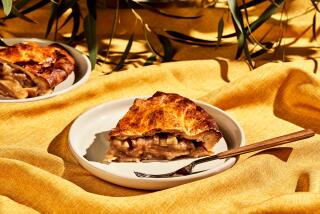An Apple (or More) a Day
An apple is not an apple is not an apple. That much is obvious. They are red, they are green, even golden. Some are crisp, some are soft. Some are tangy and some are sweet.
And, according to cookbooks, some are for cooking and some are not. That always bugged me--not because I doubted that it was true, but because I could never keep straight which were which.
Was it Granny Smith that was a cooking apple, or was it Golden Delicious? Or Gala? Or Rome Beauty? Or even Jonagold? Every time someone said “cooking apple,” I had to look it up. And then I had to take some book’s word for it.
One recent weekend, I decided to find out for myself. I went to three supermarkets and bought every apple variety I could find, intending to try them all and sort the raw from the cooked. (You kill time your way; I’ll do it my way).
The first thing I learned is that despite the loss of some great heirloom varieties, there are a surprising number of apples still available. True, some of the old favorites like Northern Spy and Esopus Spitzenberg are gone, but they’ve been replaced by others, many of them quite, well, delicious. In all, I found almost a dozen apple varieties. And that’s without going to the farmers market.
Having caught my apples, the next step was to cook them. So, one variety at a time, I peeled and cored a pound of apples, combined them in a saucepan with two tablespoons of sugar and two tablespoons of water (to keep them from sticking) and cooked them over medium heat. Then I watched what happened.
The results were interesting. First of all, we can put this whole “cooking apple” thing to rest. Almost all apples cook well. The only exception was the Red Delicious, which my tasting notes describe as “gray, musty, tastes like wet cardboard.”
But all apples cook differently. Instead of cooking or non-cooking, apples should be described more specifically. Are they firm or soft when cooked? Are they tangy or sweet? Are they pale or golden? Are they buttery? Are they spicy?
You find all combinations of these. The Granny Smith, for example, the common wisdom’s cooking apple, is very firm, pale and tart when cooked, keeping that good, fresh-apple acidity. A Gala, one of the relatively new West Coast varieties imported from New Zealand, is softer and turns golden and buttery with a hint of spice.
And so it goes.
The firmest apples, the ones that would be best for apple pies or baked apples, for which you want the fruit to hold together, were the Granny Smith, Gala, Fuji and Golden Delicious, in roughly descending order. The softest apples, which are best for applesauce and apple butter, are the McIntosh, Jonagold and Rome Beauty.
Granny Smith, Jonathan, McIntosh and Pippin were the tartest apples. Fuji, Gala, Golden Delicious and Jonathan were the most buttery. If you want a bit of spice, buy Galas or Braeburns.
Then you get to the really interesting stuff. Varietally true applesauces are fine, but when you start mixing apple types, you get some really delicious combinations.
You can plot these out, if you like, figuring that a tart, firm Granny Smith will pair nicely with a softer, more buttery Jonathan. And then maybe you’d like some Braeburn for spice.
On the other hand, you can leave it to chance. The best applesauce I’ve ever made was when I combined the leftovers from all of my experiments in one big container to keep in the refrigerator.
Of course, there were 10 pounds of it. That’s enough for eight days of latkes and even more. Applesauce overkill? Perhaps. But for at least a couple of weeks, I had no questions about cooking apples.
QUINCE AND APPLE SAUCE (LOW-FAT COOKING)
Quinces are delicious in applesauce, adding a musky spiciness and a delicate pink color. Unfortunately, they take much longer to cook than apples. The solution is to cut the quinces very thin and the apples very large. This way, the two are done at about the same time. If you’re one of those people who habitually douse applesauce with ground cinnamon or cloves, taste this one before you season. It probably won’t be necessary.
1 quince, peeled, cored and thinly sliced
6 apples, any but Red Delicious, peeled, cored and quartered
1/4 cup water
6 tablespoons sugar
Combine quince, apples and water in medium saucepan. Cover tightly and cook over medium heat, stirring occasionally to keep from sticking. When quince is tender, about 20 minutes, add sugar and cook until apples begin to fall apart, about 5 minutes. Finish the puree with hand-held immersion blender or potato masher.
6 servings. Each serving:
130 calories; 1 mg sodium; 0 cholesterol; 0 fat; 34 grams carbohydrates; 0 protein; 0.95 gram fiber.
*
Bowl from Pottery Shack, Laguna Beach.
More to Read
Eat your way across L.A.
Get our weekly Tasting Notes newsletter for reviews, news and more.
You may occasionally receive promotional content from the Los Angeles Times.











